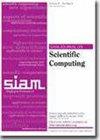Multigrid Preconditioning for Regularized Least-Squares Problems
IF 2.6
2区 数学
Q1 MATHEMATICS, APPLIED
引用次数: 0
Abstract
SIAM Journal on Scientific Computing, Ahead of Print.Abstract. In this paper, we are concerned with efficiently solving the sequences of regularized linear least-squares problems associated with employing Tikhonov-type regularization with regularization operators designed to enforce edge recovery. An optimal regularization parameter, which balances the fidelity to the data with the edge-enforcing constraint term, is typically not known a priori. This adds to the total number of regularized linear least-squares problems that must be solved before the final image can be recovered. Therefore, in this paper, we determine effective multigrid preconditioners for these sequences of systems. We focus our approach on the sequences that arise as a result of the edge-preserving method introduced in [S. Gazzola et al., Inverse Problems, 36 (2020), 124004], where we can exploit an interpretation of the regularization term as a diffusion operator; however, our methods are also applicable in other edge-preserving settings, such as iteratively reweighted least-squares problems. Particular attention is paid to the selection of components of the multigrid preconditioner in order to achieve robustness for different ranges of the regularization parameter value. In addition, we present a parameter trimming approach that, when used with the L-curve heuristic, reduces the total number of solves required. We demonstrate our preconditioning and parameter trimming routines on examples in computed tomography and image deblurring.
正则化最小二乘问题的多网格预处理
SIAM 科学计算期刊》,提前印刷。 摘要在本文中,我们关注的是如何高效求解与采用旨在强制恢复边缘的正则化算子的 Tikhonov 型正则化相关的正则化线性最小二乘问题序列。平衡数据保真度和边缘强制约束项的最佳正则化参数通常不是先验已知的。这就增加了在恢复最终图像之前必须解决的正则化线性最小二乘问题的总数。因此,在本文中,我们将为这些系统序列确定有效的多网格预处理。我们的研究重点是[S. Gazzola 等,Inverse Problems,36 (2020),124004] 中介绍的保边方法所产生的序列,在这种情况下,我们可以利用正则化项作为扩散算子的解释;不过,我们的方法也适用于其他保边设置,例如迭代重权最小二乘问题。我们特别关注多网格预处理组件的选择,以便在正则化参数值的不同范围内实现稳健性。此外,我们还介绍了一种参数修剪方法,当与 L 曲线启发式一起使用时,可以减少所需的求解总数。我们以计算机断层扫描和图像去模糊为例,演示了我们的预处理和参数修剪例程。
本文章由计算机程序翻译,如有差异,请以英文原文为准。
求助全文
约1分钟内获得全文
求助全文
来源期刊
CiteScore
5.50
自引率
3.20%
发文量
209
审稿时长
1 months
期刊介绍:
The purpose of SIAM Journal on Scientific Computing (SISC) is to advance computational methods for solving scientific and engineering problems.
SISC papers are classified into three categories:
1. Methods and Algorithms for Scientific Computing: Papers in this category may include theoretical analysis, provided that the relevance to applications in science and engineering is demonstrated. They should contain meaningful computational results and theoretical results or strong heuristics supporting the performance of new algorithms.
2. Computational Methods in Science and Engineering: Papers in this section will typically describe novel methodologies for solving a specific problem in computational science or engineering. They should contain enough information about the application to orient other computational scientists but should omit details of interest mainly to the applications specialist.
3. Software and High-Performance Computing: Papers in this category should concern the novel design and development of computational methods and high-quality software, parallel algorithms, high-performance computing issues, new architectures, data analysis, or visualization. The primary focus should be on computational methods that have potentially large impact for an important class of scientific or engineering problems.

 求助内容:
求助内容: 应助结果提醒方式:
应助结果提醒方式:


